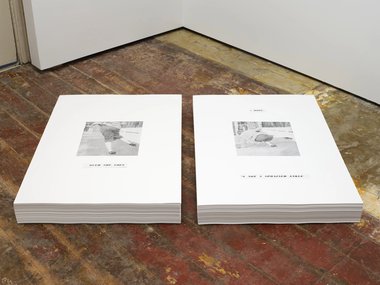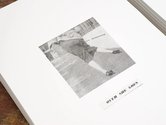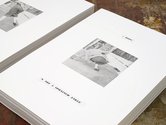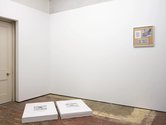John Hurrell – 1 July, 2024
There is perhaps a sense of sympathy for the depicted woman's painful experience. There may also be an aura of humiliation in having these embarrassing images presented in public. Even sadism. We don't know her name (or see her face) so maybe that claim is a bit excessive. Although the fact that a camera caught the accident at least twice looks sinister, and not a coincidence.
On the floor, two stacks of off-set prints depict (in photographic sequence) a lady in a jacket and skirt toppling over onto the footpath. Seen from behind she is diagonally suspended in mid-air. Her high heels seem to have caused this unfortunate accident. The caption on the right hopes she hasn’t sprained her ankle. In contrast, ‘Over she goes,’ as an introductory caption on the left, is nasty and smart-alecky.
The images, published originally in a women’s magazine from seventy years ago, were found cut out in a scrapbook someone gave the artist. The two piles of prints are on the floor for people to buy cheaply from the gallery.
There is perhaps a sense of sympathy for the depicted woman’s painful experience. There may also be an aura of humiliation in having these embarrassing images presented in public. Even sadism. We don’t know her name (or see her face) so maybe that claim is a bit excessive. Although the fact that a camera caught the accident at least twice looks sinister, and not a coincidence.
On a nearby wall we find a framed set of newspaper clippings—where one (alongside a photograph) is about a pair of stilettos that have little wheels attached to their tips. Notably frictionless, these wee bobbins (initially designed to go on sewing machines as spools for cotton) make the footwear very prone to slipping. The newspaper cutting Seymour provides says that the wheels are there on the shoes to prevent the heel tips leaving pock marks on lino or parquet floors. That explanation clearly is nonsense.
Rather than being a useful way to preserve floors, this photographed pair of peculiar shoes instead seems to be a surrealist object, like Man Ray’s famous iron (The Gift, 1921) with glued-on protruding tacks extending in a line down the flat sole. Functionality is inverted; usefulness for perambulation is destroyed.
On the opposite wall is an aluminium rectangle displaying a fractured text where the original newspaper oblong has been sliced in half and the sections swapped over, so that the words are broken up and the pieces shuffled around. A metaphor for shattered bones perhaps? Or damaged dignity?
Looking overall at this installation, one wonders whether Seymour is being deliberately opaque, and not talking about the perils of walking in high heels down a sidewalk at all, but the act of reading: metaphorically dwelling on accuracy versus misreading. So-called ‘slippage’—where mistakes are made through perusing too quickly or inattentively. Wrong words, or wrong meanings from right words. A falling away from or diminishing of normally accepted meaning.
This is might be an extravagant misinterpretation—but one nevertheless interesting. Perhaps though, the most obvious explanation for regular gallery-goers is that Seymour (if she has a message beyond a sly winking—possibly cruel—humour) is attracted to stilettoes as fetish items that she has often depicted in her art practice. They have a sharp and dangerous allure that shares a commonality with the extended claws of her apparently favourite photocopied subject-matter, cats.
John Hurrell










 Advertising in this column
Advertising in this column Two Rooms presents a program of residencies and projects
Two Rooms presents a program of residencies and projects



This Discussion has 0 comments.
Comment
Participate
Register to Participate.
Sign in
Sign in to an existing account.